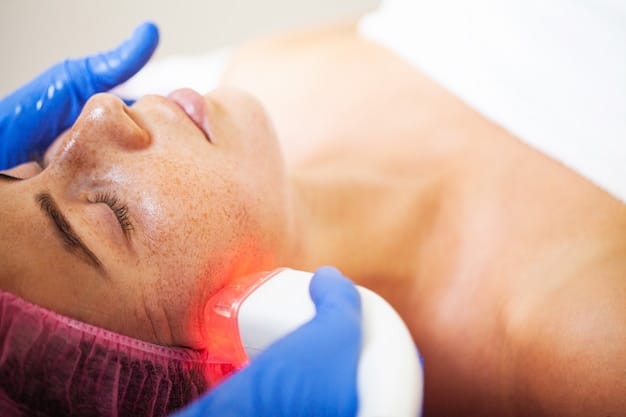Treating Hyperpigmentation: Fading Dark Spots in 6 Months

Treating hyperpigmentation effectively involves a multifaceted approach combining topical treatments like retinoids and vitamin C, in-office procedures such as chemical peels and laser therapy, and strict sun protection to achieve a more even skin tone within approximately six months.
Are you tired of seeing dark spots and uneven skin tone when you look in the mirror? Achieving a clear and radiant complexion is within reach. This guide explores effective methods for treating hyperpigmentation: fading dark spots and achieving even skin tone in 6 months, offering practical tips and professional insights to help you reclaim your skin’s natural beauty.
Understanding Hyperpigmentation and Its Causes
Before diving into treatments, it’s crucial to understand what hyperpigmentation is and what triggers it. Hyperpigmentation is a common skin condition where patches of skin become darker than the surrounding areas. Knowing the causes helps in choosing the most effective treatment.
What is Hyperpigmentation?
Hyperpigmentation occurs when melanin, the pigment that gives skin its color, is overproduced in certain areas. This overproduction can lead to various types of dark spots and uneven skin tone.
Common Causes of Hyperpigmentation
Several factors can contribute to hyperpigmentation, including sun exposure, hormonal changes, inflammation, and skin injuries. Understanding these triggers can help prevent further darkening and guide treatment strategies.

- Sun Exposure: UV rays stimulate melanin production, leading to sunspots and worsening existing hyperpigmentation.
- Hormonal Changes: Conditions like melasma are often triggered by hormonal fluctuations, such as those during pregnancy or from hormone therapy.
- Inflammation: Skin conditions like acne, eczema, or injuries can cause post-inflammatory hyperpigmentation (PIH) as the skin heals.
Understanding the causes of hyperpigmentation is the first step toward effective treatment. By identifying the triggers, you can tailor your skincare routine to address these specific factors and prevent future dark spots.
Topical Treatments for Fading Dark Spots
Topical treatments are a cornerstone of hyperpigmentation management. These include over-the-counter (OTC) and prescription products that lighten dark spots and promote a more even skin tone. Consistency is key when using topical treatments.
Over-the-Counter (OTC) Options
OTC products contain active ingredients in lower concentrations, making them suitable for mild hyperpigmentation. Look for products with ingredients like vitamin C, glycolic acid, and azelaic acid.
Prescription-Strength Treatments
For more stubborn hyperpigmentation, prescription treatments containing retinoids, hydroquinone, or kojic acid can be more effective. These treatments should be used under the guidance of a dermatologist due to their potency.
- Retinoids: Promote cell turnover and reduce the appearance of dark spots.
- Hydroquinone: A powerful skin-lightening agent that inhibits melanin production.
- Kojic Acid: A natural ingredient that helps to lighten skin and even out skin tone.
Topical treatments are a fundamental part of any hyperpigmentation treatment plan. By choosing the right products and using them consistently, you can gradually fade dark spots and achieve a more uniform complexion.
Professional In-Office Procedures for Hyperpigmentation
When topical treatments aren’t enough, professional in-office procedures offer more intensive solutions for hyperpigmentation. These procedures are performed by dermatologists and can deliver faster and more noticeable results. Consulting with a dermatologist is essential to determine the best option for your skin type and condition.
Chemical Peels
Chemical peels involve applying a chemical solution to the skin, which exfoliates the top layers to reveal smoother, more even-toned skin underneath. Different types of peels target various depths of hyperpigmentation.
Laser Therapy
Laser treatments use concentrated light energy to target and break down melanin in the skin. This can significantly reduce the appearance of dark spots and improve overall skin tone.

- Types of Chemical Peels: Options include superficial, medium, and deep peels, each suited for different levels of hyperpigmentation.
- Types of Laser Therapy: Common lasers used include Q-switched lasers, fractional lasers, and intense pulsed light (IPL).
- Benefits of Professional Procedures: Can provide faster and more dramatic results compared to topical treatments alone.
Professional in-office procedures can provide significant improvements in hyperpigmentation. These treatments can be highly effective under the care of a skilled dermatologist.
The Role of Sun Protection in Preventing and Treating Hyperpigmentation
Sun protection is paramount in both preventing and treating hyperpigmentation. UV radiation from the sun stimulates melanin production, which can darken existing spots and cause new ones to form. Incorporating sun protection into your daily routine is non-negotiable.
Understanding UV Radiation
UVA and UVB rays both contribute to hyperpigmentation. UVA rays penetrate deeper into the skin, causing long-term damage, while UVB rays are responsible for sunburn. Broad-spectrum sunscreen protects against both types of radiation.
Choosing the Right Sunscreen
Select a broad-spectrum sunscreen with an SPF of 30 or higher. Look for formulations that are non-comedogenic and suitable for your skin type. Mineral sunscreens containing zinc oxide or titanium dioxide are excellent choices.
- SPF Levels: SPF 30 blocks 97% of UVB rays, while SPF 50 blocks 98%.
- Application Tips: Apply sunscreen generously 15-30 minutes before sun exposure and reapply every two hours, or immediately after swimming or sweating.
- Additional Protection: Wear protective clothing, hats, and sunglasses to minimize sun exposure.
Sun protection is the cornerstone of preventing and treating hyperpigmentation. By making it a daily habit, you can protect your skin from further damage and maintain an even skin tone.
Lifestyle and Dietary Changes to Support Skin Health
Beyond topical treatments and professional procedures, lifestyle and dietary changes can play a supportive role in improving skin health and reducing hyperpigmentation. A holistic approach that addresses internal and external factors can enhance your overall results.
The Impact of Diet on Skin Pigmentation
A balanced diet rich in antioxidants, vitamins, and minerals can help protect skin cells from damage and support healthy melanin production. Incorporate foods like fruits, vegetables, and lean proteins into your daily meals.
Stress Management and Its Effects on Skin
Chronic stress can exacerbate skin conditions and contribute to hyperpigmentation. Practicing stress-reducing activities like yoga, meditation, or deep breathing exercises can help improve your skin’s appearance.
- Foods to Include: Berries, leafy greens, fatty fish, and nuts are rich in antioxidants and essential nutrients.
- Stress Reduction Techniques: Regular exercise, mindfulness, and adequate sleep can lower stress levels and improve skin health.
- Hydration: Drinking plenty of water keeps skin hydrated and supports optimal cell function.
Adopting a healthy lifestyle and making mindful dietary choices can complement your hyperpigmentation treatment plan, leading to healthier, more radiant skin.
Creating a 6-Month Skincare Routine for Even Skin Tone
Achieving even skin tone in six months requires a dedicated and consistent skincare routine. This involves incorporating effective treatments, practicing sun protection, and making lifestyle adjustments. Here’s a step-by-step guide to help you create a routine that works.
Morning Skincare Routine
Start your day with a gentle cleanser, followed by a vitamin C serum to protect against environmental damage. Finish with a broad-spectrum sunscreen with an SPF of 30 or higher.
Evening Skincare Routine
In the evening, cleanse your skin thoroughly and apply a retinoid or other prescription treatment as directed by your dermatologist. Follow with a hydrating moisturizer to prevent dryness and irritation.
- Sample Routine: Morning: Cleanser, Vitamin C Serum, Sunscreen. Evening: Cleanser, Retinoid (or other treatment), Moisturizer.
- Consistency is Key: Stick to your routine consistently for at least six months to see noticeable results.
- Adjustments: Monitor your skin’s response and adjust your routine as needed, consulting with a dermatologist for guidance.
A well-structured and consistent skincare routine is essential for fading dark spots and achieving an even skin tone within six months. By combining effective treatments with proper sun protection and a healthy lifestyle, you can achieve remarkable improvements in your skin’s appearance.
| Key Point | Brief Description |
|---|---|
| ☀️ Sun Protection | Daily use of broad-spectrum SPF 30+ to prevent new dark spots. |
| 🧪 Topical Treatments | Use retinoids, vitamin C, and hydroquinone to fade existing spots. |
| 👩⚕️ Professional Procedures | Consider chemical peels and laser therapy for faster results. |
| 🥦 Healthy Lifestyle | Balanced diet and stress management to support skin health. |
Frequently Asked Questions (FAQ)
How long does it typically take to see results from hyperpigmentation treatment?
▼
Results vary, but with consistent treatment and sun protection, noticeable improvements can often be seen within 2-3 months, with more significant fading by 6 months.
▼
Results vary, but with consistent treatment and sun protection, noticeable improvements can often be seen within 2-3 months, with more significant fading by 6 months.
▼
While complete cures aren’t always possible, hyperpigmentation can be significantly lightened and managed with the right treatments and preventative measures.
▼
Some natural remedies like aloe vera and green tea extract may help, but they are generally less effective than clinical and pharmaceutical treatments like retinoids.
▼
It’s best to consult with a dermatologist before combining treatments to ensure they are compatible and won’t cause irritation or adverse effects.
▼
Consistent sun protection, a healthy skincare routine, and avoiding triggers like excessive sun exposure or harsh skincare products are crucial for prevention.
Conclusion
Treating hyperpigmentation: fading dark spots and achieving even skin tone in 6 months involves a comprehensive approach that addresses the root causes and utilizes effective treatments. With dedication, consistency, and the guidance of a skincare professional, achieving a clearer, more radiant complexion is entirely possible.





